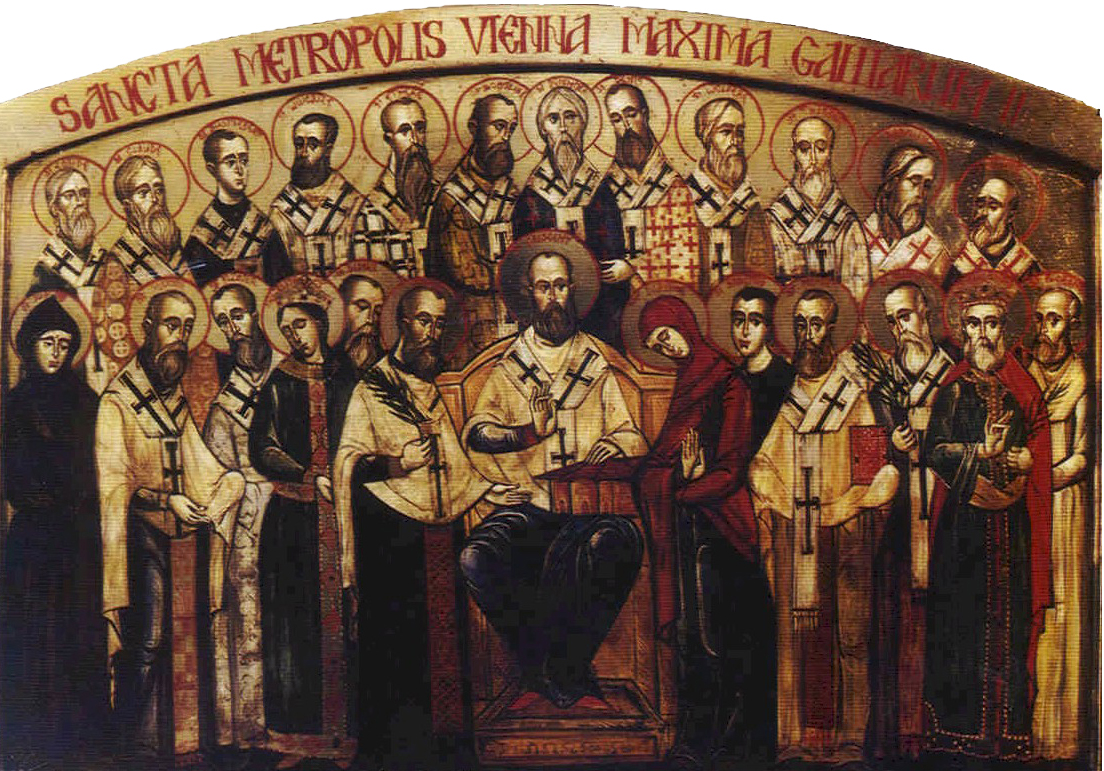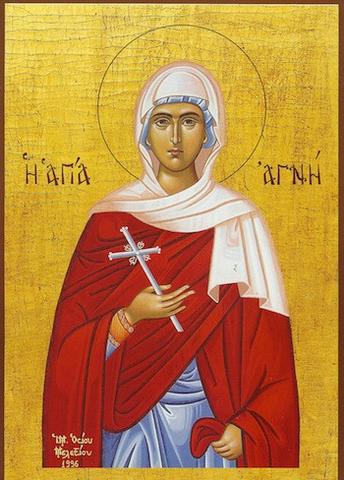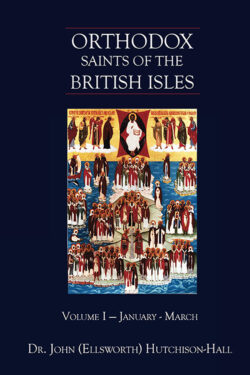
Orthodox Saints of the Pre-Schism
See of Rome
3rd February (NS) — 21st January (OS) 2025
AGNES, there are several legends regarding St. Agnes' martyrdom, circa 254 - 305, none of which can be verified. Of the most popular ones, she is either taken to a temple dedicated to the Roman goddess of Minerva, where she refuses to offer a sacrifice and so is martyred. In another she is tried for being a Christian, condemned to death at the stake, and then beheaded when the flames miraculously failed to burn her. All legends place her age at twelve or thirteen and agree that she was buried on the Via Nomentana, in Rome.
BRIGID (BRIGA) of KILBRIDE, she flourished in the late fifth, or early sixth centuries in Lismore, Co. Waterford. According to legend, St. Brigid of Kildare (1st February) visited her more than once at Kilbride. According to the noted 17th century hagiographer and historian John Colgan O.F.M. (†c. 1657), the now-lost Calendar of Cashel styles her St. Brigid of Killbrige.
EPIPHANIUS, renown for his sanctity, charity, and the gift of wonderworking, St. Epiphanius was elected Bishop of Pavia circa 467. The primary source of information on St. Epiphanius' life comes from the still extant Vita Epifanius by his contemporary, friend, and later Bishop of Pavia, St. Ennodius (17th July). During his life St. Epiphanius negotiated on behalf of his flock with the Emperor Anthemus (r. 467–472), Euric, King of the Visigoths (r. 466–484), and the Ostrogoth commander Theodoric. St. Epiphanius served as an Ambassador to the court of Euric at Toulouse, and accompanied by St. Ennodius, led a mission to Gundobad King of the Burgundians (r. c. 474–516). He played a vital role in the rebuilding of Pavia following its destruction by the forces of Odoacer. St. Epiphanius reposed circa 497, his relics were translated to Hildesheim in Lower Saxony in 963.
FRUCTUOSUS, AUGURIUS, AND EULOGIUS, Martyrs of Tarragoña, during the Valerian Persecution (257 – 260) Fructuosus, Bishop of Tarragoña, and his two deacons, Augurius and Eulogius, were ordered to make offerings to Roman gods. Refusing to apostatise, they declared their faith in the one true God, and were condemned to be burnt at the stake. Later, St. Augustine of Hippo (28th August), composed a Panegyric on St. Fructuosus.
LAWDOG, four churches in the Welsh diocese of St. David’s are named for this sixth century saint. It is possible that he is the same saint as St. Llenddad (15th January), Abbot of Bardsey, however there is no further information about him extant.
MACCALLIN (MACALLAN) , an Irishman, who along with his companion St. Cadroe (6th March), is credited with the being the founding Abbot of the Abbey of Waulsort, in present-day Hastière in the province of Namur, Belgium. St. Maccallin reposed in 978.
MEINRAD, originally from present-day eastern France, and according to some sources a member of the House of Hohenzollern; St. Meinrad received monastic tonsure at Reichenau Abbey in Lake Constance in present-day Baden-Württemberg, Germany. After many years at Reichenau, St. Meinrad lived as a hermit at what became Einsiedeln Abbey in the Swiss Caton of Schwyz. One day in 861, he gave shelter to two men who turned out to be robbers. Upon finding nothing of value at his hermitage, they beat St. Meinrad to death. Though there is no evidence that he specifically died for the Faith, due to his sanctity, St. Meinrad has always been considered a martyr.
PATROCLUS, a wealthy and charitable Christian noble in Troyes in Gaul. During a local persecution of Christians, St. Patroclus was arrested and martyred for the Faith, either in 275 or 259, depending upon the source.
PUBLIUS, venerated as the first Bishop of Malta, according to tradition St. Publius is the 'chief man of the island of Malta', who befriended St. Paul after his shipwreck (Acts 28:7). St. Publius was martyred circa 112.
VIMIN (WYNNIN, GWYNNIN), there being no reliable information on this saint extant, we are left to legend to piece together a Life of sorts. He seems to have been the founder and first Abbot of the monastery of Holywood in Fife, and according to one tradition was a bishop. St. Vimin reposed 579. Anglican Bishop Alexander Forbes (†1875) Kalendar of Scottish Saints has some interesting (though of doubtful reliability) details about him, and the Aberdeen Breviary contains the Liturgical Office for the Feast of St. Vivian.
Get your copy of Orthodox Saints of the British Isles today.
Available at Amazon or your favourite e-bookstore.
ANATOLIUS, a ninth century bishop in Scotland who, following a pilgrimage to Rome, quit his See to live as a hermit near present-day Salins-les-Bains, France.
ANSGAR (ANSCHAR), a native of Amiens, who, at a young age, received monastic tonsure at the Abbey of St. Peter of Corbie in Picardy (L'abbaye royale Saint-Pierre de Corbie - Old Corbie) where he was a disciple of SS. Adelard (2nd January) and Paschasius Radbert (26th April). Sent as a missionary to Scandinavia, St. Ansgar founded the first church in Sweden, and the first Christian school in Denmark. He was also part of the group of monks who were dispatched from Old Corbie, to Saxony to found New Corbie, where St. Ansgar served as Abbot for a time. He was the first Archbishop of Hamburg and appointed Papal Legate to Scandinavia by Pope Gregory IV. St. Ansgar was known for his great skill as a preacher, devotion to the poor and sick, as well as a wonderworker. St. Ansgar reposed at Bremen in 865.
BERLINDA (BERLINDIS, BELLAUDE), a noble maiden who lived a life of prayer in a monastery near Alost in Flanders. St. Berlinda was a niece of St. Amandus (6th February), and reposed in 702.
CAELLAINN (CAOILFIONN), St. Caellainn was an Irish saint for whom a church in Roscommon is dedicated. she is thought to have lived in the sixth century; however, there is no information about her extant.
CELERINUS of CARTHAGE, according to some sources he was a nephew of SS. Laurentius, Laurentinus, Ignatius, and Celerina (vide infra), who suffered imprisonment and torture in Rome during the Decian Persecution. Following his release, St. Celerinus returned to Carthage where St. Cyprian (16th September) ordained him to the Diaconate. He reposed circa 250, and due to the treatment he was subjected to in Rome, St. Celerinus has always been counted amongst the martyrs.
DEODATUS, (Eighth Century), a monk at Lagny Abbey (L'abbaye Saint-Pierre de Lagny) outside of Paris.
FELIX, SYMPHRONIUS (SEMPRONIUS), HIPPOLYTUS, and COMPANIONS, (Date Unknown), the listings in early martyrologies of this group as having been Africans who suffered there notwithstanding, later scholarship has led to a variety of theories as to where their martyrdom actually took place. The lack of extant lives makes it impossible to say with any certainty.
HADELIN, a disciple of St. Remaclus (3rd September) who also ordained him to the Priesthood. St. Hadelin, along with St. Remaclus founded the Abbey of Our Lady of Chelles in present-day Meaux, France. He spent his final years as a hermit near Dinant on the River Meuse, reposing circa 690.
IA (HIA, IVES), an Irish Princess, and sister of St. Erth (31st October), she travelled to Cornwall with SS. Fingar, Phiala, and Companions (14th December). She suffered martyrdom under King Teudar on the River Hayle in 450. St. Ia has left her name to the Cornish town of St. Ives, which grew up around her grave.
LAURENCE the ILLUMINATOR, St. Laurence, along with three hundred orthodox companions, fled Monophysite persecution in 514, and after a stay in Rome where he was priested, settled in Umbria. St. Laurence founded a monastery near Spoleto, where he had been elevated to the Episcopate. After twenty years in that See, he resigned and founded the Abbey of Farfa north of Rome. St. Laurence reposed at Farfa in 576.
LAURENTIUS, LAURENTINUS, IGNATIUS, and CELERINA, (Third Century), martyrs in North Africa during the Decian Persecution. According to some sources they were brothers and sister, and Aunt and Uncles of St. Celerinus of Carthage (vide supra).
LIAFDAG, first Bishop of Ribe in Jutland. St. Liafdag was martyred by pagans in 980.
LUPICINUS and FELIX, (Fifth Century), listed in martyrologies as Bishops of Lyons, St. Lupicinus is generally said to have reposed circa 486. St. Felix, who is said to have been St. Lupicinus' contemporary, was in all likelihood bishop of a different See. However, the lack of any documentation, means nothing certain of their lives is known beyond their mention in early martyrologies.
OLIVER (OLIVERIUS, LIBERIUS), a monk at the Abbey of Santa Maria di Portonuovo in Ancona. St. Oliver reposed circa 1050. No further information is extant.
PHILIP of VIENNE, tenth Archbishop of Vienne, serving from circa 560 until his repose in 578.
TIGIDES and REMEDIUS, two Bishops of Gap, St. Remedius from 394 to 419. St. Tigides, is said to have been his predecessor. However, aside from brief notes in the Martyrologium Hieronymianum and Acta Sanctorum, there is no evidence that St. Tigides ever existed.
WERBURH (WERBURGA, WERBURGH), the daughter of the Mercian king, Wulfhere (r. 658–675), and St. Eormenhild (13th February), St. Werburh (less correctly ‘Werburgh’), was placed under the care of her aunt, St. Æthelthryth of Ely (23rd June). She lived a life of great sanctity and usefulness eventually becoming abbess, and under the instigation of her uncle King Æthelred (r. 675–704), worked to reform the monasteries of nuns in his kingdom. St. Werburh also established new monasteries at Trentham and Hanbury (in Staffordshire) and at Weedon (in Northants). She reposed circa 699 at Trentham, but her relics were translated to Chester in 875 to safeguard them from Danish invaders. Her shrine, fragments of which are still to be seen in Chester Cathedral, reportedly the site of many miracles, was destroyed during the reign of Henry VIII. St. Werburh is the patron saint of Chester.
WERBURGH, St. Werburgh was a widow who became a nun, most likely at Bardney in England, where she later served as Abbess. It is believed she reposed circa 785, and nothing further is known about this saint.
Prior to the Schism the Patriarchate of Rome was Orthodox, and fully in communion with the Orthodox Church. As Saint John of Shanghai and San Francisco +1966 said “The West was Orthodox for a thousand years, and her venerable Liturgy is far older than any of her heresies”.
Details of British Saints excerpted from Orthodox Saints of the British Isles.
Details of continental saints from these sources.
In many cases there are several spelling versions of the names of saints from the British Isles. I use the Oxford Dictionary of National Biography version as the primary version with the more prevalent version in parenthesis e.g. Ceadda (Chad) of Lichfield.


